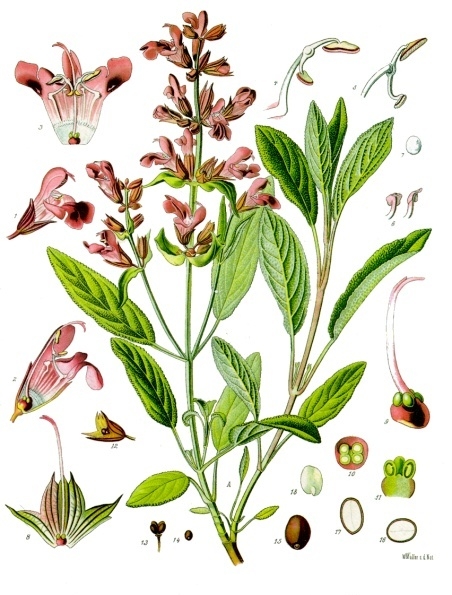
Reproduction
Sage is a flowering plant that reproduces via pollen. Because
it is a flowering plant, it is considered an angiosperm, meaning
"covered seed." Sage has a similar life cycle to many other
angiosperms, which features an alternation of generations,
meaning both the gametophyte and sporophyte adults are
multi-cellular organisms. Humans, in comparison, do not
have an alternation of ge nerations and only have a single-celled
sperm and egg. Although, in most angiosperms, the gametophyte is
extremely reduced and the plant that most of us observe is the
adult sporophyte.
nerations and only have a single-celled
sperm and egg. Although, in most angiosperms, the gametophyte is
extremely reduced and the plant that most of us observe is the
adult sporophyte.
Sage is a perennial herb, meaning that it grows during the spring and summer months and then dies off over the fall and winter months and then is still able to grow again the next year. Sage usually blooms around June and has a blue or lavender coloring. This blue and lavender coloring attracts butterflies to carry its pollen.
The life cycle of sage starts with a mature, flowering sage plant. Anther (as seen in the top right of the picture) in the flower produce spores via meiosis. Meiosis is a type of cell division and reproduction in which the diploid parent cell divides into four genetically different haploid daughter cells. These spores form groups of four, called tetrads, that are known as pollen grains. The pollen grains are then transferred by wind or other organisms to other sage plants. Once pollen is successfully transferred, it germinates on the ovary of the plant and they fuse together to form a diploid zygote. This process is called germination. This formation produces the seed which will give rise to a new sage plant. This seed has the newly made embryo within it and it provides nutrition and protection for the embryo.
For many plants, this life cycle can be hard to complete because in many cases plants rely on wind pollination. Wind pollination can be unsuccessful and it can take a large amount of energy for the plant to produce a large amount of pollen. To compensate, many angiosperms have adapted coloration of their flowers to attract insects that can carry their pollen, such as bees, butterflies, and many others. This provides the pollen a direct path to another flower. This is an adaptation that can significantly reduce the amount of energy a plant has to use for reproduction.
Many other plants have a similar life cycle, check out the life cycle of a Hot Pepper.
To see how sage interacts with other organisms and the environment, continue to Interactions.
To check out other awesome organisms, check out the Multiple Organisms website!